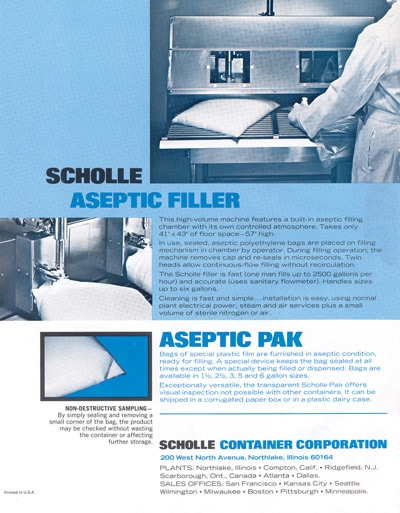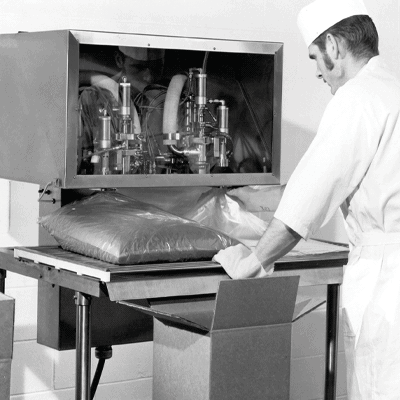

Scholle IPN invented the bag-in-box and revolutionized the way we package goods. Since then, we have continued to find innovative and game-changing ways to utilize packaging technology to transport food safely while reducing our environmental impact.
Scholle IPN began utilizing low-acid aseptic filling technology 40 years ago. Aseptic packaging introduces a sterilized product into a sterilized package and requires no refrigeration and no preservatives. The challenge with low-acid items—think milk, a low-acid product, versus tomato sauce, a high-acid product—is that their pH levels aren’t low enough to ward off bacterial growth on their own. This makes packaging these products a challenge. Before low-acid aseptic technology, the only way to package low-acid items to keep them shelf-stable was to add preservatives or to use hot-fill or retort. While both methods are effective in preventing bacterial growth, they require packaging that can withstand high heat, like aluminum and glass, extracting more resources from the planet. They also have a greater effect on product quality.
Low-Acid Aseptic: Second-to-None
The benefits of low-acid aseptic technology are felt both inside the package and out. It’s clear that being able to package and store sensitive food items without preservatives is a win, but eliminating the need for refrigeration means cutting out cold storage throughout the distribution stream. “What low-acid packaging does is it takes the product out of the refrigerated supply chain,” Halverson says. “Those are huge savings because [restaurants] don’t have to refrigerate the product. And if you go to any restaurant, you know storage is a tight commodity.”
The importance of low-acid technology is really felt when you extrapolate outward. There are hundreds of thousands of restaurants in the United States alone—and the restaurant industry is just a small sliver of where low-acid packaging can make an impact. “[Low-acid] has basically changed the baby food market—before low-acid, all of those products that were in pouches were treated with heat. So you’re eliminating the vitamins and the texture and the nutrients in baby food this way,” Halverson notes. “To use low-acid aseptic technology to pasteurize baby food and put it into a pouch without preservatives is a big deal.”
Halverson sees low-acid aseptic transforming other industries. “I hope to see coffee shops use low-acid packaging for their nut milks,” Halverson says. “A one-and-a-half-liter of cashew milk, or oat milk, or whatever milk you’d like with a tap offers the convenience of no air getting to the product. What we offer to the wine industry would be offered to the dairy industry. You wouldn’t have to throw an unused half carton of milk away because you didn’t have enough customers that day.”







